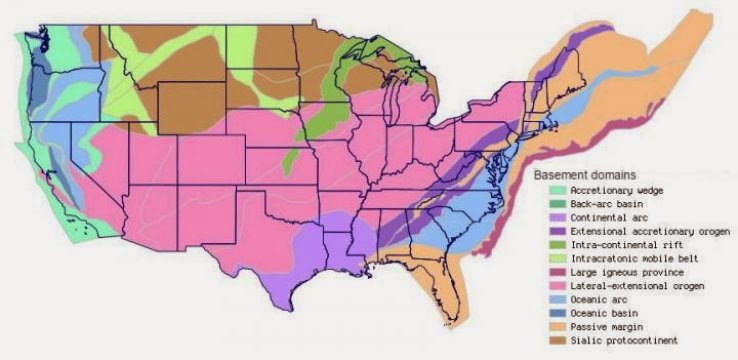
A map showing the many different pieces of Earth’s crust that comprise the nation’s geologic basement is now available from the U.S. Geological Survey. This is the first map to portray these pieces, from the most ancient to recent, by the events that influenced their composition, starting with their origin. This product provides a picture of the basement for the U.S., including Alaska, that can help scientists produce regional and national mineral resource assessments, starting with the original metal endowments in source rocks.
“Traditionally, scientists have assessed mineral resources using clues at or near the Earth’s surface to determine what lies below,” said USGS scientist Karen Lund, who led the project. “This map is based on the concept that the age and origins of basement rocks influenced the nature and location of mineral deposits. It offers a framework to examine mineral resources and other geologic aspects of the continent from its building blocks up,” said Lund.
More than 80 pieces of crust have been added to the nation’s basement since the Earth began preserving crust about 3.6 billion years ago. These basement domains had different ages and origins before they became basement rocks, and this map includes these as key factors that determined their compositions and the original metals that may be available for remobilization and concentration into ore deposits. The map further classifies the basement domains according to how and when they became basement, as these events also influence the specific metals and deposit types that might be found in a region.
Users can identify domains potentially containing specific metals or deposit types. They can configure the companion database to show the construction of the U.S. through time. The map also provides a template to correlate regional to national fault and earthquake patterns. The map is also available on a separate site, where users can combine data and overlay known mineral sites or other features on the domains.
Basement rocks are crystalline rocks lying above the mantle and beneath all other rocks and sediments. They are sometimes exposed at the surface, but often they are buried under miles of rock and sediment and can only be mapped over large areas using remote geophysical surveys. This map was compiled using a variety of methods, including data from national-scale gravity and aeromagnetic surveys.
Crustal rocks are modified several times before they become basement, and these transitions alter their composition. Basement rocks are continental crust that has been modified by a wide variety of plate tectonic events involving deformation, metamorphism, deposition, partial melting and magmatism. Ultimately, continental crust forms from pre-existing oceanic crust and overlying sediments that have been thus modified.
It is not only the myriad processes that result in varying basement rock content but also the time when these processes occurred during the Earth’s history. For example, because the Earth has evolved as a planet during its 4.5 billion year history, early deposit types formed when there was less oxygen in the atmosphere and the thin crust was hotter. The ancient domains are now more stable and less likely to be altered by modern processes that could cause metals to migrate. By contrast, basement rocks that formed out of crust that is less than one billion years old have origins that can be interpreted according to the present-day rates and scales of plate tectonic processes that reflect a more mature planet with a thicker crust.
By incorporating ancient to modern processes, this map offers a more complete and consistent portrait of the nation’s geologic basement than previous maps and presents a nationwide concept of basement for future broad-scale mineral resource assessments and other geologic studies.
Note: The above story is based on materials provided by United States Geological Survey.










